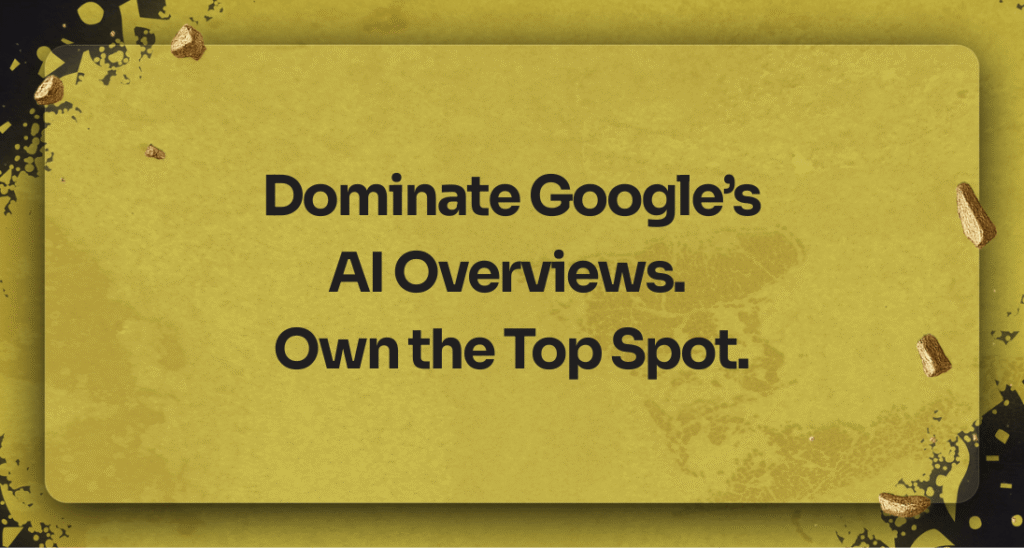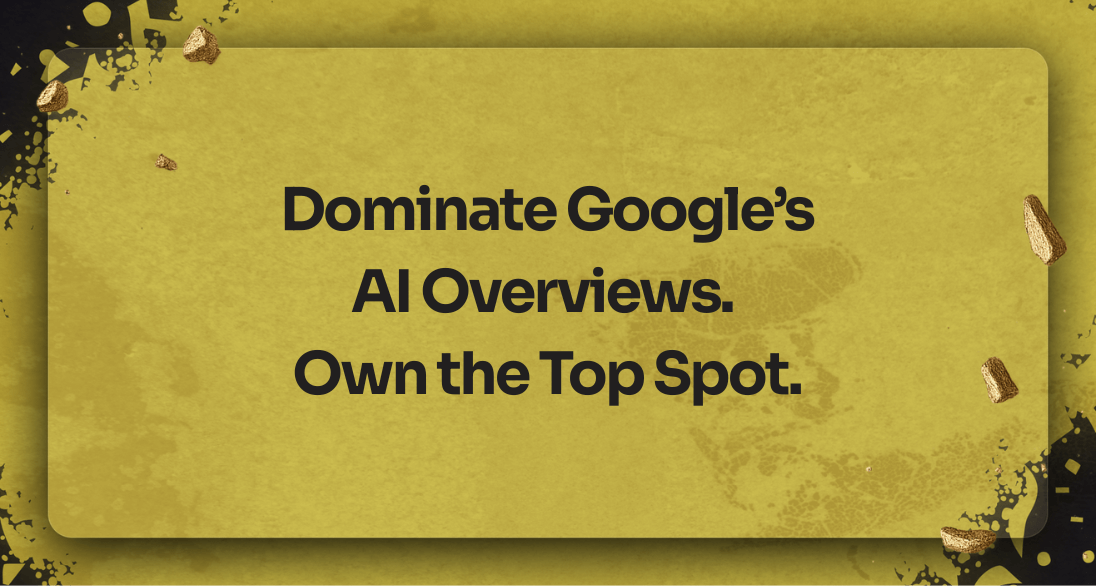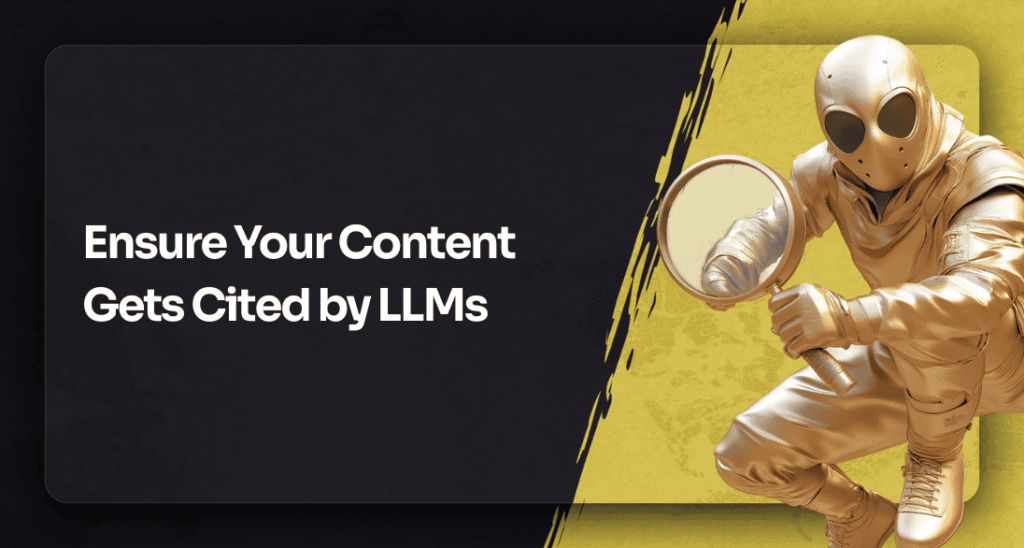Since launching AI Overviews in May 2024, Google’s been moving traffic off your site and into its own boxes.
By March 2025, Semrush found these AI-driven summaries showed up in 13.14% of all searches - double what it was at the start of the year. And nearly 9 in 10 of those are informational searches.
Own a website? Get ready: AI Overviews are lurking and they can wipe out 50% of your clicks in some markets.
And Google’s just getting started.
Still, there’s good news: The door’s wide open for brands who know how to rank in Google AI Overviews.
We'll show you what makes AI Overview tick, how it differs from traditional search results, and the specific techniques that turn your content into a cited source.
Ready to steal some visibility?
Understand How AI Overviews Work
Google's AI Overviews are a complete reimagining of how information gets surfaced and consumed. If you want to crack this code, you need to understand the machine.
What are AI Overviews and How Are They Generated?
AI Overviews are AI-generated summaries that appear at the top of search results, giving users quick answers without the click-through dance. They can run several hundred words long and shove organic results further down the page, depending on the query.
Unlike basic algorithm-driven results, these AI snapshots are powered by Google's customized Gemini language model. They don't just regurgitate training data. Instead, they hook directly into Google's core web ranking systems to identify relevant, high-quality results from their index.
The generation process? Sophisticated doesn't begin to cover it.
AI Overviews use a "query fan-out" technique, firing off multiple related searches within subtopics and data sources to build comprehensive responses. This means they pull information from diverse sources rather than betting everything on a single website.
AI Overviews appear in approximately 47% of search engine results pages as of mid-2025, though this varies by query type. They show up most frequently for informational queries, appearing in about 59% of searches with informational intent. Commercial intent? They only appear in roughly 19% of those searches.
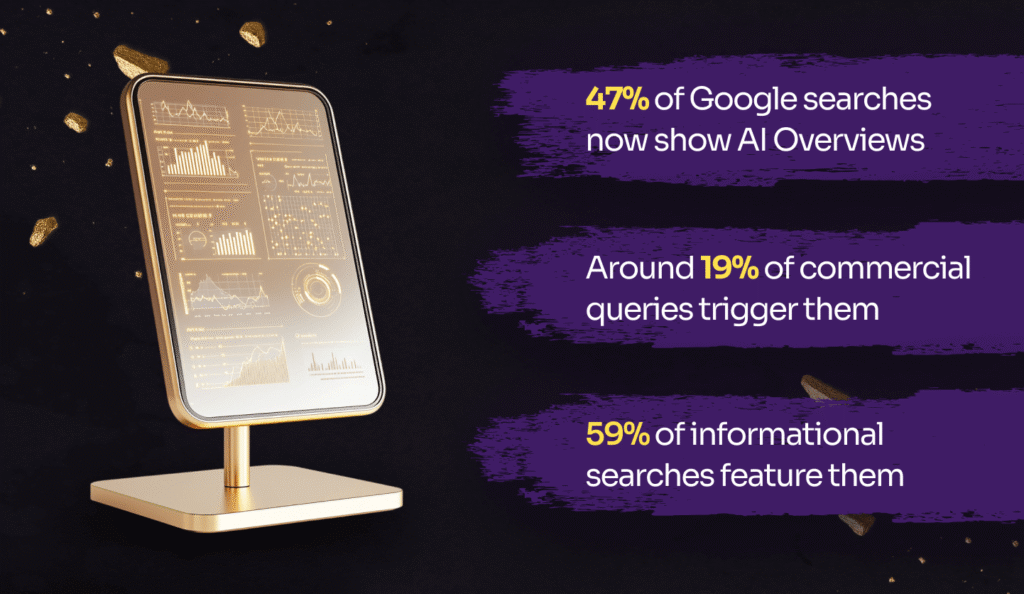
How AI Overviews Differ From Traditional Search Results
Position is everything.
AI Overviews claim the top spot on the SERP, above every other feature - including Google Ads and organic rankings. First thing users see after searching.
Traditional search results and featured snippets typically pull from a single source.
AI Overviews?
On average, they provide links to 5.4 external sources when expanded, creating a more comprehensive response.
The format adapts based on query type. Mini informational articles, step-by-step guides, comparison tables, interactive results. This flexibility enables them to match user intent regardless of query complexity.
User behavior shifts dramatically too. With traditional search results, users scan through multiple listings before finding what they need.
AI Overviews often satisfy the query directly on the search page. Over 58% of Google searches now result in zero clicks, meaning users find what they need without ever visiting external websites.
Why AI Overviews Matter for SEO in 2025
Being featured in AI Overviews offers distinct advantages. Google claims that: "With AI Overviews, people are visiting a greater diversity of websites for help with more complex questions."
Plus, the links included in AI Overviews tend to receive more clicks than if the page had appeared as a traditional web listing for that query.
When users do click through from AI Overviews, these clicks are typically higher quality - users are more likely to spend more time on the site. This happens because AI results give people more context about a topic and display more relevant supporting links than traditional search results.
For businesses focused on AI Overviews optimization, understanding this trade-off is crucial. While overall click volume may decrease, visibility in AI Overviews can significantly boost brand awareness.

To rank in Google AI Overviews, brands must adapt their AI search engine optimization strategies to prioritize content that directly answers user queries in a concise, authoritative manner. Those who understand and optimize for this new search paradigm will gain a significant competitive advantage in 2025 and beyond.
Optimize Content for AI Understanding
Understanding how to rank in AI Overviews starts with recognizing that AI doesn’t read like humans. It scans for patterns, structure, and clear signals about what your content means and which questions it answers best.
Content optimization is how you make sure your pages are easy for machines to parse and impossible for Google to ignore.
Use Clear, Concise Language and Short Paragraphs
AI-powered search engines scan pages like speed readers, looking for structural clues to quickly understand your content.
When crafting content for AI understanding, stick to short, digestible paragraphs of one to three sentences maximum. Long, complex sentences reduce clarity and increase the risk of misinterpretation by both AI and human readers.
AI models favor content using concise, declarative statements over content with more complex or equivocal language.
Whenever possible, present information as clear, direct facts rather than opinions - this helps AI extract definitive snippets to include in its summaries.
Writing in a natural, conversational tone works best. AI models have become extremely good at understanding context and intent, favoring content that reads like it was written for humans, not search engines.
As Google explicitly recommends, use natural language and avoid an over-optimized, keyword-stuffed approach.
For optimal AI understanding, your content should be:
- Explanatory rather than brief
- Written in simple English rather than complex vocabulary
- Structured with proper heading hierarchy (H1-H6)
- Formatted with semantic HTML elements
Answer the Main Query Early in the Content
For each question your content addresses, start with a concise answer in the first paragraph. That’s a core step in how to rank in Google AI Overview search engine.
This is particularly beneficial for featured snippets, as Google often pulls content from these first few lines.
The inverted pyramid method (putting the main point first, followed by supporting details) works exceptionally well.
When answering search queries, a suggested structure includes:
- Using the question as your title or part of it
- Briefly introducing the topic
- Answering the question directly and immediately
- Providing in-depth explanation afterward
- Adding practical steps or tips
Fast-loading pages and important content placed near the top of your HTML increase the odds that AI crawlers (operating under tight efficiency budgets) will fully capture your message.
Use Semantic Keywords to Improve Context
Beyond basic keyword optimization, succeeding with AI Overviews requires comprehensive topic modeling. This translates to building semantic clusters of related terms that together create a multidimensional picture of the topic.
Semantic search focuses on understanding the meaning and intent behind user queries, using natural language processing to improve the accuracy and relevance of search results.
Instead of merely looking for literal matches between search queries and indexed content, it aims to deliver more relevant results by considering the relationships between words.
For instance, a user searching for "warm clothing" could be served results about "sweaters" or "coats" despite no direct keyword match. This semantic understanding allows AI to provide more helpful responses.
To optimize for semantic search:
- Use semantically rich terms related to your main topic
- Cover the topic comprehensively from multiple angles
- Include related terminology that reflects authentic user queries
Naturally incorporate common questions your audience asks. AI models are increasingly adept at understanding how concepts relate to each other.
The technical foundation for this is Natural Language Processing (NLP), which allows search engines to grasp context and intent, not simply keywords. This technology enables AI systems to interpret linguistic nuances, context, tone, and intentions behind words.
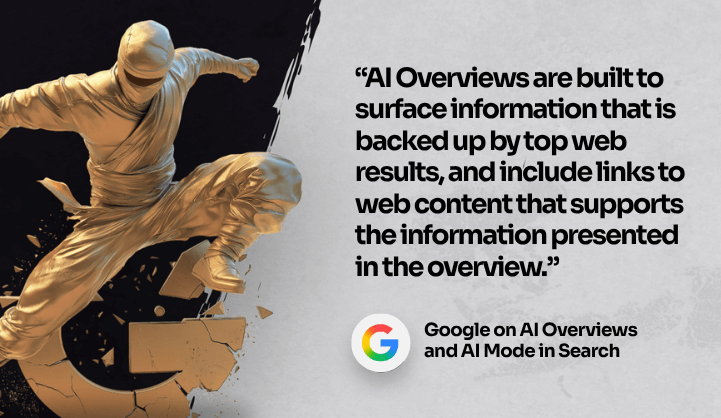
Structure Your Content for AI Overviews
Want to know what separates content that gets featured from content that gets ignored?
Structure.
Get your structure wrong, and even brilliant content becomes invisible.
Use Headings and Subheadings Effectively
AI systems treat your heading structure like a table of contents.
They scan H1s, H2s, and H3s first to understand what your page covers and how concepts relate to each other.
The rules are simple:
- One H1 tag that clearly defines your topic
- Logical H2s and H3s that follow natural hierarchy
- Keywords in headings without forcing them
- Descriptive headings over clever ones
Think of headings as signposts. When they're missing or poorly implemented, AI systems get lost trying to extract meaningful information from your content.
No signposts? No citations.
Add Bullet Points and Numbered Lists
Lists are AI gold. AI Overviews often pull bulleted lists directly from content, especially for step-by-step guides or key takeaways.
Why do lists work so well?
- They present discrete pieces of information clearly
- They signal important points worth highlighting
- They're easier for AI to extract and repurpose
- They match how AI models structure responses
Keep your lists consistent in structure and relatively short: 5-7 points ideal. Longer lists can overwhelm AI systems, reducing your chances of being featured.
Include Tables and Comparison Formats
Tables are secret weapons for AI Overview visibility.
Google's AI particularly favors structured data formats when answering comparison-based queries.
The structured table layout enables AI models to quickly recognize relationships between data points, increasing the likelihood that your content will be referenced.
For effective tables:
- Keep column headers clear and descriptive
- Use actual text (not images) for all table content
- Include relevant metrics for easy comparison
- Limit table width to ensure mobile compatibility
Text Fragments for Direct Linking
Text fragments (specific content sections marked with start and end points) have emerged as a powerful tool for improving visibility in AI search results.
Using them isn’t just good UX - it’s part of how to rank in Google AI Overview by guiding AI directly to your best answers.
They work as anchors, allowing search engines to zero in on particular parts of your page.
The implementation? Append a URL with #:~:text= followed by the targeted text. This technique guides AI algorithms to your most valuable content sections, increasing the chances they'll be extracted for AI Overviews.
Use text fragments to highlight:
- Direct answers to common questions
- Statistical data or research findings
- Key conclusions or takeaways
- Expert opinions or quotes
Structure isn’t decoration. It’s how you make your content impossible for AI to miss, read, and extract. Nail this, and you’re not just helping humans - you’re flashing neon signs to AI about what’s valuable and worth pulling into the spotlight.
Technical SEO for AI Crawlers: Optimize for Discovery
Behind every successful page lies solid technical SEO that helps crawlers find, process, and understand your content efficiently.
Page Speed and Mobile Optimization: The Traffic Gatekeepers
Google evaluates your page’s Core Web Vitals (LCP, INP, CLS) to judge how fast, stable, and responsive your site is: all factors that influence your chances of being surfaced in search results and AI Overviews.
When your site loads quickly, AI crawlers can process more pages within their allocated crawl budget.
Mobile optimization? Equally crucial.
Almost every search engine now primarily uses your site's mobile version for crawling and indexing. The better experience you provide to mobile users, the more likely your content will appear in AI-generated answers.
This means that you should:
- Implement responsive design that adapts to different screen sizes
- Compress images while preserving quality
- Enable browser caching to store static files locally
- Consider using a Content Delivery Network (CDN) to distribute content globally
The faster, cleaner, and more mobile-friendly your site is, the higher your chances of landing in AI Overviews and keeping traffic flowing to your pages.
HTTPS: Security That Ranks
Since 2014, Google has used HTTPS as a ranking signal, and today browsers flag HTTP sites as "not secure" - a warning that can destroy traffic and conversions.
HTTPS protects data transmitted between users and your website with three critical layers:
- Encryption: Prevents activity tracking and information theft
- Data integrity: Stops files from being corrupted during transfer
- Authentication: Verifies website legitimacy and builds trust
HTTPS sites enjoy faster loading times. This speed advantage occurs because HTTPS runs security checks more efficiently than HTTP.
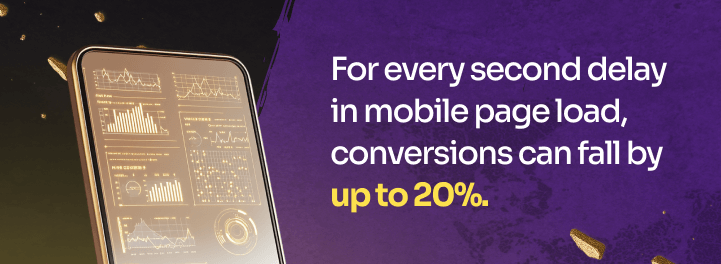
Running an e-commerce site? HTTPS is mandatory. Shoppers won’t trust their payment info to an unsecured page. Even for blogs and informational sites, users now expect secure connections for all web interactions.
Structured Data: The AI Roadmap
Structured data adds machine-readable context that helps AI crawlers grasp your content’s meaning and structure. Schema.org markup acts as a roadmap, guiding AI systems to interpret your pages accurately.
Google has stated structured data doesn't directly improve rankings, but it remains crucial for AI overview visibility because it helps clarify content meaning.
The most valuable schema types include:
- Article
- FAQ Page
- Product
- Person
- Organization
Using the "Article" schema signals to AI systems that your page contains article content, making it easily identifiable as a potential source for queries seeking article-based information.
For maximum effectiveness, implement schema using JSON-LD format added to your HTML. This approach helps define what your page is about, who created it, and how different parts relate to each other.
Validate your implementation using Google's Rich Results Test to check for errors and identify potential improvements. This ensures your structured data is correctly formatted and eligible for enhanced visibility in search results.
Knowing how to rank in AI Overviews means pairing solid technical SEO with effective content structure and optimization.
Build Authority and Trust Signals
According to Google’s Search Quality Rater Guidelines, content needs clear signals of expertise and trust to qualify as reliable and that’s just as true for AI Overviews.
No matter how well you structure your page, weak authority means weak visibility.
Showcase Author Credentials and Expertise
For AI systems, the who behind your content matters tremendously. AI-generated answers prefer sources with clear subject matter expertise.
Adding author bylines that link to dedicated profile pages increases your chances of appearing in AI Overviews. These profiles should include:
- Professional credentials and certifications
- Relevant work experience in your field
- Links to social media profiles and/or published works
This structured data helps search engines understand your authors' qualifications, creating stronger expertise signals that boost your site authority.
Earn Backlinks from Reputable Sources
Backlinks function as votes of confidence in your website, signaling to AI systems that others find your content valuable.
But not all links carry equal weight: AI Overviews favor citations from established industry publications and trusted platforms.
To build a backlink profile that boosts your chances of AI overviews optimization:
- Create original research and data-backed reports others will cite
- Pursue guest posting opportunities on authoritative platforms
- Respond to relevant HARO (Help A Reporter Out) queries
- Fix broken links on industry websites with your content
Link building fuels AI visibility. The right backlinks tell Google your content deserves the AI Overview box.
Track and Adapt Your AI SEO Strategy
Google doesn’t provide native tracking for AI-generated results like it does for traditional rankings.
Instead, you’ll need tools like Semrush, Similarweb, or custom SERP monitoring scripts to spot when AI Overviews appear, which competitors are cited, and how your pages perform.
Use Tools to Monitor AI Overview Visibility
Tools like Semrush, Sistrix, and SE Ranking identify which keywords trigger AI Overviews and whether your brand appears in those results. Newer platforms such as Scrunch AI also track mentions in AI search engines including ChatGPT, Perplexity, and Google.
These tools pinpoint:
- Which domains AI systems cite most often
- Shifts in your AI visibility over time
- Citation trends for specific industries or topics
Know your position. Stay competitive.
Update Content Regularly to Stay Relevant
AI systems favor fresh, current information. Regular content updates ensure your pages remain relevant, accurate, and useful - critical factors for maintaining visibility in Google's AI Overviews.
Start here: identify which of your pages already appear in AI Overviews using your tracking tools.
Then prioritize updating those pages with:
- Latest statistics and research findings
- Current industry trends and developments
- Enhanced formatting that aligns with AI preferences
Stay current, or stay invisible.
Test and Iterate Based On Performance Data
Monitoring isn't enough. Successful AI search engine optimization requires continuous experimentation by testing AI-generated content additions.
To implement effective testing:
- Conduct A/B tests on different content structures
- Analyze which citation formats drive more traffic
- Examine user engagement signals like heatmaps and scroll depth
Evaluate conversion indicators on your site (sales, signups, engagement metrics) as these better reflect the true value of AI-driven traffic.
Track everything. Test constantly. Adapt quickly.
Wrap Up
AI Overviews now dominate search results, forcing every content creator to choose: adapt or become invisible.
Learning how to rank in AI Overviews isn’t complicated, but it requires commitment on multiple fronts. Clear, semantic-rich content helps AI systems understand your expertise quickly.
Smart structure (headings, lists, tables, and text fragments) makes your information easy to extract. Technical foundations like page speed, HTTPS security, and structured data give AI crawlers what they need to index your material properly.
Authority remains king. Your content must demonstrate real expertise through author credentials and earn validation through quality backlinks.
Brands that master these strategies will emerge as trusted information sources, earning valuable visibility even as traditional organic clicks decline. Those who resist will watch their competitors steal their traffic.
The mission stays the same: help users, earn trust, and publish with intent. AI Overviews are simply the new battleground where that mission plays out.
Frequently Asked Questions
Q: How to rank in Google AI Overviews?
To rank in Google AI Overviews, focus on clear, concise content that answers user questions directly. Use structured data, semantic keywords, and strong technical SEO. Combine authority signals like backlinks and expert authorship to improve your chances of being cited in AI-generated summaries.
Q: How can I optimize my content for AI Overviews?
To optimize for AI Overviews, focus on creating clear, concise content that directly answers user queries. Use semantic keywords, implement proper heading structures, and include lists and tables. Ensure your content is mobile-friendly, loads quickly, and includes structured data markup.
Q: What role does authority play in ranking for AI Overviews?
Authority is crucial for ranking in AI Overviews. Showcase author expertise through detailed bios and credentials, earn backlinks from reputable sources, and maintain an active presence on social media platforms. These signals help AI systems recognize your content as trustworthy and authoritative.
Q: How many sources does Google cite in an AI Overview?
On average, AI Overviews include links to about 5 external sources when expanded. This allows Google to provide users with diverse perspectives and deeper information beyond a single website.
Q: Are AI Overviews replacing featured snippets?
Not entirely. AI Overviews often appear in addition to traditional featured snippets. While they can push snippets further down the page, both features can coexist, and your content can still rank in either (or both) depending on the query.
Q: How often should I update my content to stay relevant for AI Overviews?
Regular content updates are essential to maintain relevance for AI Overviews. Aim to refresh your content periodically, especially for pages that already appear in AI-generated summaries. Update statistics, industry trends, and formatting to align with AI preferences.
Q: Can AI-generated content rank in AI Overviews?
Yes, AI-generated content can rank in search results, including AI Overviews. However, it's important to ensure the content is high-quality, provides value to users, and is properly optimized for search engines. Always review and refine AI-generated content before publishing.
Q: How can I track my website's performance in AI Overviews?
Tracking your website’s performance in AI Overviews requires specialized tools, as Google doesn’t offer native reporting for AI-generated results. Use platforms like Semrush, Sistrix, or SE Ranking to see which keywords trigger AI Overviews and whether your brand appears in them. For broader coverage, tools like Scrunch AI monitor mentions within AI search engines, including ChatGPT, Perplexity, and Google.

